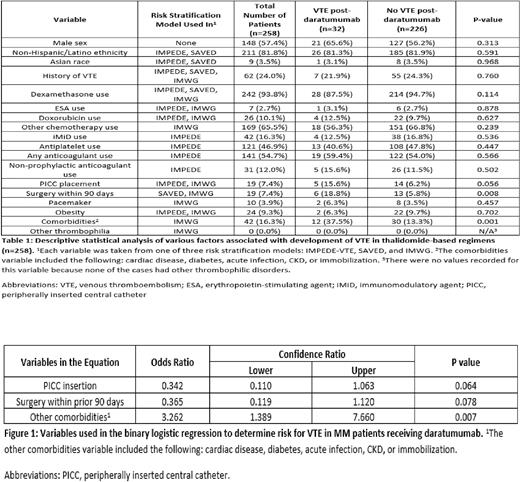Abstract
Introduction:
Hematologic malignancies, especially multiple myeloma (MM), are associated with a high risk for venous thromboembolism (VTE). In MM, multiple factors increase the risk of VTE including, but not limited to, different treatments. The most recognized therapies that increase VTE risk for MM are immunomodulator drugs (IMIDs), steroids, and carfilzomib. Monoclonal antibodies (mAbs), usually in combination with other treatments, have become the therapy of choice for transplant- and non-transplant candidates in newly diagnosed MM (NDMM) as well as those with relapsed and/or refractory disease (RRMM).
Daratumumab is an anti-CD38 monoclonal antibody incorporated in several combination regimens, and its specific effect on VTE risk is not well known. Previous studies have tried to identify clinical and therapy-related factors associated with VTE risk, with limited data on VTE risk and monoclonal antibodies (Wang, J Leuk Lymphoma, 2021). This study aims to identify if an increased risk of VTE exists for patients undergoing treatment with daratumumab-based regimens in efforts to develop a future risk assessment model that incorporates mAbs.
Methods:
We retrospectively reviewed the medical records of consecutively identified patients who received daratumumab, registered in a data warehouse designed to study the interference of monoclonal antibodies and blood typing procedures, at MD Anderson Cancer Center (MDACC) for the treatment of MM between April 2014 and February 2021. The study was approved by the institutional review board at MDACC. Eligible patients were screened for upper and lower extremity deep venous thrombosis (DVT) and pulmonary embolism (PE) through doppler ultrasound and contrast enhanced radiology reports, respectively, within 365 days after the date of the first dose of daratumumab. A natural language processing algorithm was used to determine the likely VTE positive cases and then was confirmed with manual chart review. Patients were divided into two categories, based on the timing of VTE diagnosis relative to the first dose of daratumumab: VTE post-daratumumab versus non-VTE post-daratumumab. The co-variates of interest were derived from three previous VTE risk stratification systems (SAVED, IMPEDE-VTE, and IMWG) and the differences were compared within the two category-VTE groups.
All variables of interest were analyzed using descriptive statistics. Chi-square test or Fisher exact test were used to assess the association between categorical variables, and non-parametric methods were used for continuous numeric variables. Variables with statistically significant differences between VTE-category groups (p≤ 0.05) were analyzed using a binary logistic regression to determine their effect on the VTE occurrence.
Results:
Out of 258 eligible patients, 32 had evidence of VTE post-daratumumab, for a VTE incidence of 12.4% at 12 months from the initiation of daratumumab. The median time to VTE from the first dose of daratumumab was 3.9 months (IQR 1.6 - 6.1 months). Of the variables tested, we identified that the presence of central venous access (PICC), surgery within the previous 90 days before the initiation of daratumumab, and the history of comorbidities (cardiac disease, CKD, acute infection, or immobilization) were more prevalent in patients with VTE (Table 1). In the logistic regression analysis, only the presence of comorbidities (p = 0.007) was significant to the risk of VTE, but PICC line insertion (p = 0.064) and surgery within the previous 90 days (p = 0.078) were not (Figure 1). The odds of having a new VTE was 3.3 (95% CI, 1.4-7.7).
Conclusions:
The incidence of VTE during daratumumab therapy appears to be high (>10% in 12 months). The use of concurrent chemotherapy and thalidomide-derivative agents did not appear to increase the risk of VTE in those patients. The presence of comorbidities was the only independent factor associated to the risk of VTE in that cohort. This study suggests that while the incidence of VTE in MM patients is high, the main contributing risk factors for VTE are dynamic and the interplay between those factors changes along the disease course. After validation, these findings could influence and improve current VTE risk assessment models and update primary thromboprophylaxis guidance for improved patient outcomes.
Disclosures
Aung:Helena Lab: Consultancy, Research Funding. Patel:Janssen, Celgene/BMS, Caribou Sciences, Arcellx, Cellectis, Merck, Pfizer, Karyopharm, Oncopeptides: Consultancy. Lee:Legend Biotech: Consultancy; Immunitas Therapeutics: Consultancy; Amgen: Research Funding; Genentech: Consultancy; GSK: Consultancy, Research Funding; Regeneron: Research Funding; Janssen: Research Funding; Sanofi: Consultancy; Karyopharm: Consultancy; Pfizer: Consultancy; Monte Rosa Therapeutics: Consultancy; Oncopetides: Consultancy; Takeda Pharmaceuticals: Consultancy, Research Funding. Rojas Hernandez:Daichii Sankyo: Research Funding; ASPEN Pharmaceuticals: Research Funding; ANTHOS Therapeutics: Research Funding.
Author notes
Asterisk with author names denotes non-ASH members.


This feature is available to Subscribers Only
Sign In or Create an Account Close Modal